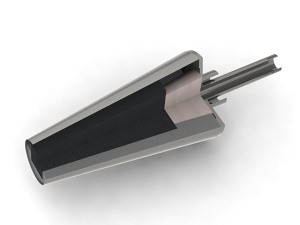Analysis of the characteristics of diffused breathable bricks
Because of its microstructure characteristics, the new diffused ventilation bricks will not cause the bottom-blow-through or bad phenomenon that the original slotted ventilation bricks often present with the slits. A large temperature gradient occurs in the flow in the slit, and part of the thermal stress that occurs is concentrated near the slit, especially the thermal stress at the outlet of the slit, which makes the size of the slit change during use, and causes the molten steel to simply invade the slit. In the middle, the bottom blowing is not penetrated or the phenomenon is bad. Also, if the bottom blowing valve is quickly closed after purification, the molten steel will enter the slit with positive pressure, so it is necessary to install a reverse infiltration one-way stop valve on the argon blowing pipeline. Therefore, the slit type ventilation The brick must have a suitable and stable slit air channel size and a material with good thermal stability to reduce the slit steel. The ventilation channel of the diffused ventilation brick is a large number of connected pores dispersed inside the brick body (as shown in Figure 2). ), these micron-scale curved channels form a large resistance to molten steel infiltration, and are basically non-permeable to steel in actual use. The air bubbles generated by the diffused ventilation brick are small, uniform and dense, and it is easier to stir the molten steel to a uniform temperature , It is easier to promote the inclusions to float up and achieve a better extraction effect.
The new diffused permeable brick is not easy to cross the surface of the brick core. When the ordinary slit type permeable brick is blown with argon, the outlet of the slit is in direct contact with the high-temperature molten steel and the cold air flows continuously, resulting in a large temperature gradient, forming a slit The thermal stress at the air outlet is particularly large, coupled with the effect of rapid cooling and rapid heating during use, the cross-section near the air outlet of the slit simply occurs, causing the slit to shift and the bottom to blow through. Thermal stress, it is easy to form the cross-section of the slit-type breathable brick, which puts forward relatively high requirements for the thermal shock resistance of the refractory material. However, there are micron-scale gas channels on the entire working surface of the diffused breathable brick, and the working surface temperature The gradient is small, so the new diffused breathable brick is not easy to cross the surface of the brick core.

Related News
- Introduction of construction method of ramming material in intermediate frequency furnace
- How to choose the material of furnace lining
- The difference between rammer and castable
- Application direction of intermediate frequency furnace refining
- Introduction to the construction method of dry ramming material
- Do you know the production process and control points of breathable bricks?
- The application of argon blowing technology at the bottom of the intermediate frequency furnace
- Method for prolonging service life of intermediate frequency furnace lining
- In addition to diffused breathable bricks, there are those types of breathable bricks
- What are the advantages of coil cement
- What are the good coil glues?
- Furnace lining manufacturers tell you the steps of the oven
- What should be paid attention to in the knotting process of wear-resistant ramming material
- Refractory manufacturers tell you the reason for the damage to the boiler lining
- Introduction to the method of improving the argon blowing rate of ladle permeable bricks
- Ramming material manufacturers teach you how to test the performance of refractory materials
- Cause Analysis of Damaged Furnace Lining
- Influence of Furnace Lining Material on Pre-furnace Temperature of Copper Alloy
- Brief introduction of furnace lining baking process
- What are the points of a good furnace lining


